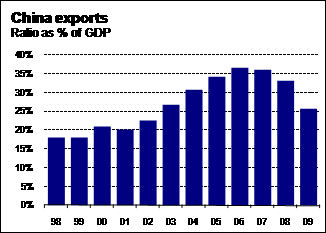Can we really count on China?
As China’s economy continues to hum along, a major economic transition is taking place. China is starting to move away from export-intensive growth towards greater domestic demand. At the same time, China’s cheap labour advantage is giving way to more focus on value-added. Questions have been raised about China’s ability to keep growing amid a sluggish global recovery and unwinding government stimulus. But a moderate recovery in exports and a steady rise in domestic demand will be enough for China to maintain growth of around 8-9%pa over at least the next five years.
China’s transformation has been the subject of numerous economic predictions and much research over the last few years. China has already become a major player on the world stage, and has a significant influence on global demand, trade, and commodity prices. China looks set to continue this impressive economic growth for some years yet. But further growth will not come without challenges, as over one billion Chinese consumers play catch-up with the developed world.
The Chinese economy is characterised by heavy government intervention and a high savings rate. The former factor is perhaps the real paradox of China. Although the communist party has held onto power for more than 60 years, it is the government’s recent embracing of more market-based policies that has propelled China onto the world stage as a serious economic power.
The government still micro-manages many parts of the economy and people’s personal lives. For example, in recent efforts to curb the building boom in Beijing local officials enacted tighter controls on who can buy houses and who can get loans. Third houses are out of the question, and even purchasing a second dwelling requires a 50% deposit. Such heavy-handed economic management would be unheard of in most Western economies.
China’s culture remains very conservative at heart, and there is still a high level of support for social laws, such as those limiting sexual freedom. But some high-profile cases of late have shown that these issues are bound to come to a head sooner or later, and the government may begin to give in to a generation that has increasing expectations of both economic and social freedom.
Twenty-one years on from the Tiananmen Square protests of 1989, political unrest still bubbles below the surface. As a new breed of middle-income Chinese flexes its economic muscle, many people are demanding increased freedom.
Young Chinese workers are shunning the job-for-life expectations of their parents, pushing instead for Western-style education and careers. This trend has led to reports of labour shortages in some sectors, although there are still plenty of rural Chinese chasing the opportunities of the big cities.
If demands for personal freedoms continue to intensify, there is a risk it could undermine economic growth. Resources could be directed to political (and even military) infighting, and away from growing the economy.
With the economy going well, people may be more willing to settle for restricted personal freedoms. However, if economic progress slows, there is a risk that Chinese citizens will blame the government and political unrest will intensify.
One of the major changes we expect to see in China over the next few years is a shift in focus away from exports towards domestic demand. Indeed, this process has already begun, hastened by the global financial crisis and resultant drop in global demand for China’s exports.
The Chinese are very good at saving, but as middle-class incomes grow we are likely to see a process of economic maturing. This process is likely to include a rise in both imports and domestic consumption of local production.
This prospect has some worried about the US and its ability to continue to fund its current account deficit. But the level of income growth occurring in China is impressive and should sustain America’s demand for capital, even as more money is diverted towards domestic consumption over the next few years.

Graph 1 shows that China’s reliance on exports has already eased significantly since 2007. The financial crisis accelerated this decline in 2009, aided by the Chinese government’s stimulus package which propped up domestic demand while the global economy floundered.
One of the significant debates surrounding the success of China is over its growing use of non-renewable resources. A cynic might attribute much of the economic success of the West over the past 100-200 years to colonisation, slavery, and exploitation of non-renewable resources. China’s late emergence as an economic heavyweight means it will be forced down a different route. In an increasingly carbon and pollution-conscious world, China is facing pressure that the developed world never did.
China recently became the world’s largest emitter of carbon dioxide, and now accounts for more than one-fifth of global carbon emissions. By comparison, the US is responsible for about 18% of global emissions, and Europe 14%. Of course on a per-capita basis, China is still a relatively low-carbon economy compared to the US. As China’s incomes continue to rise, this point raises the question as to what level of carbon emissions the global community will tolerate from China.
China’s envoy to the global climate-change talks, Qinghai, recently drew criticism for suggesting that the developed world should cut carbon emissions by 40% while at the same time rejecting any suggestion China should cap its emissions. Even if China agrees to a carbon emissions target, Western leaders appear to be unconvinced that China would enforce it. The Chinese government recently admitted that up to 20% of the power plants in Chinaware unlicensed and illegal.
There is a debate going on in the Chinese government, with some environmental enthusiasts arguing that it is in China’s interests to promote green technology. But cheap coal and China’s growing electricity demands threaten to derail any progress that is being made.
Pressure from foreign countries, particularly the US, maybe needed to get China on board with global climate talks. If China holds out, carbon charges in the US and other developed countries could push up China’s emissions further by giving China a new competitive advantage in manufacturing. This prospect is likely to encourage America and other nations to consider the introduction of tariffs to indirectly price Chinese carbon emissions on imported goods – a worrying outcome for China.
Foreign investment in China has been driven up in recent years by the availability of relatively cheap labour. As China continues its transition into a global economic heavyweight, this cost advantage will be one of the casualties. But this change is part of a natural progression for China, as it cannot expect to raise incomes while at the same time retaining a competitive edge in the global labour market.
Even with the hype around surging Chinese wages, it seems premature to declare a complete end to China’s labour cost advantage. In fact, the recent minimum wage hikes are more or less in line with what was stipulated in China’s 2004 labour reforms. These reforms required local governments to raise minimum wages at least once every two years. Many of the companies that have considered investing in China over the last 5-10 years are likely to have seen these wage hikes coming.
For China, rising wages will mean a move away from selling cheap labour to the world and towards an economy based more around higher value-added. Just like the "Made in Japan" brand has become a symbol of quality, over the coming years "Made in China" will begin to shed its connotations of being cheap and low-quality.
China is already beginning to develop a reputation as fledgling centre for innovation. Over the next ten years the focus will shift further towards adding value rather than churning out low-cost consumer items.
For the developed world, the next source of lower-cost labour will come from other developing countries with political stability. There is scope for further investment in India’s manufacturing sector to this end. Other parts of Asia, and in the longer-term perhaps parts of Africa, will attract investment from labour-intensive industries in the coming years.
Of course, China probably does not aspire to be like Japan in many aspects. In the early 1990s, Japan’s economic good times came to an abrupt end as its asset price bubble burst. Japan’s response to the crisis looks poor in hindsight interest rates didn’t fall below 1% until more than five years after the crisis began. Effective monetary and fiscal stimulus in Japan was virtually non-existent in the 1990s.
In contrast, China’s economic performance during the last couple of years would have been much worse were it not for the stimulatory policies of the communist government.
China’s economy is roughly 65% the size of the US in purchasing power parity (PPP) terms. Using PPP is useful for cross-country comparisons because it adjusts for differences in purchasing power between different economies.
Using a combination of historical trends, our own forecasts, and projections, we expect China to overtake the US as the world’s largest economy by around 2025. Under favourable assumptions it could happen by the early 2020s, while even under considerably unfavourable assumptions it looks set to happen by 2030 at the latest.
Of course, even when China becomes the world’s largest economy, per-capita living standards will remain significantly lower than in the US. In 15 years’ time, the more pressing question will be whether the economy and the environment can sustain millions more people aspiring to live the “American dream".

